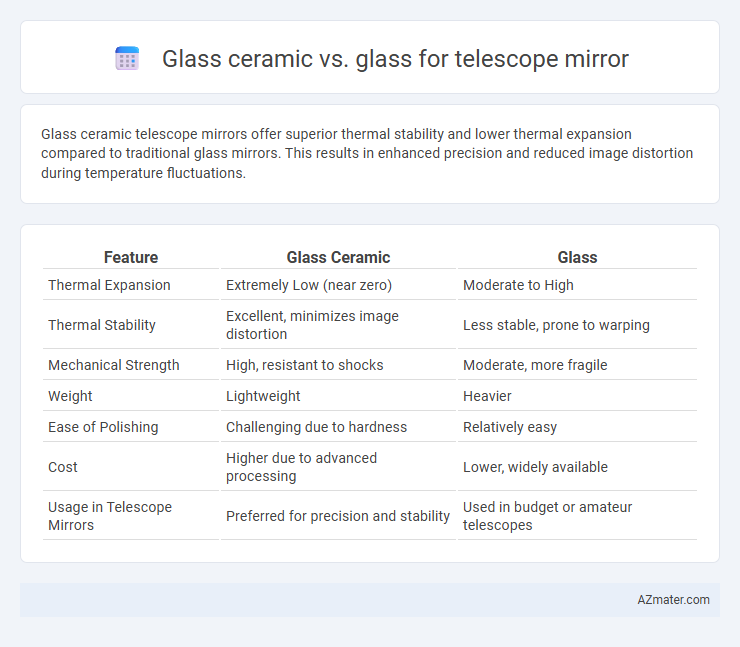Glass ceramic telescope mirrors offer superior thermal stability and lower thermal expansion compared to traditional glass mirrors. This results in enhanced precision and reduced image distortion during temperature fluctuations.
Table of Comparison
| Feature | Glass Ceramic | Glass |
|---|---|---|
| Thermal Expansion | Extremely Low (near zero) | Moderate to High |
| Thermal Stability | Excellent, minimizes image distortion | Less stable, prone to warping |
| Mechanical Strength | High, resistant to shocks | Moderate, more fragile |
| Weight | Lightweight | Heavier |
| Ease of Polishing | Challenging due to hardness | Relatively easy |
| Cost | Higher due to advanced processing | Lower, widely available |
| Usage in Telescope Mirrors | Preferred for precision and stability | Used in budget or amateur telescopes |
Introduction to Telescope Mirror Materials
Telescope mirrors commonly use glass ceramic and glass materials, each offering distinct optical and thermal properties crucial for image quality. Glass ceramics, such as Zerodur or Pyrex, provide low thermal expansion and enhanced stability, reducing distortion from temperature fluctuations. Standard glass mirrors, while more affordable, generally exhibit higher thermal expansion, making them less ideal for precision astronomical observations.
What is Glass Ceramic?
Glass ceramic is a material composed of fine glass and crystalline phases, carefully engineered through controlled crystallization to optimize thermal and mechanical properties. Unlike ordinary glass used in telescope mirrors, glass ceramics exhibit near-zero thermal expansion, significantly reducing distortion due to temperature fluctuations. This stability ensures high-precision optical performance, making glass ceramic an ideal choice for advanced telescope mirrors.
Understanding Traditional Glass
Traditional glass used in telescope mirrors, such as BK7 or crown glass, offers good optical clarity and ease of fabrication but suffers from higher thermal expansion and lower thermal stability compared to glass ceramics. Glass ceramic materials like Zerodur or Astrositall exhibit near-zero thermal expansion, enhancing mirror stability and image quality during temperature fluctuations. The improved thermal properties of glass ceramics reduce mirror deformation, making them preferable for high-precision astronomical telescopes.
Manufacturing Process: Glass Ceramic vs Glass
Glass ceramic telescope mirrors undergo a specialized manufacturing process involving controlled crystallization of glass, resulting in enhanced thermal stability and reduced thermal expansion compared to conventional glass mirrors, which are typically produced by grinding and polishing homogeneous glass blanks. The crystallization phase in glass ceramics requires precise heat treatment to develop microcrystalline structures that improve structural integrity and minimize deformation across temperature variations. Meanwhile, traditional glass mirrors rely on uniform glass composition but are more susceptible to thermal distortion, necessitating careful temperature management during observation.
Thermal Expansion and Stability Comparison
Glass ceramic materials, such as Zerodur and fused quartz, exhibit near-zero thermal expansion coefficients around 10^-7 /degC, significantly reducing mirror deformation due to temperature fluctuations. In contrast, standard glass types like BK7 have higher thermal expansion rates near 7.1 x 10^-6 /degC, resulting in less dimensional stability and increased optical distortion. The superior thermal stability of glass ceramics ensures more precise and stable telescope mirror performance, critical for high-resolution astronomical observations.
Optical Quality and Surface Finish
Glass ceramic telescope mirrors offer superior thermal stability and lower expansion rates compared to standard glass, which significantly enhances optical quality by maintaining precise surface figures under temperature fluctuations. The surface finish of glass ceramics is typically smoother and more consistent, reducing surface scatter and improving image contrast and resolution. In contrast, conventional glass mirrors are more prone to deformation and require frequent adjustments to preserve optical performance, potentially compromising long-term accuracy in astronomical observations.
Durability and Resistance to Environmental Factors
Glass ceramic telescope mirrors exhibit superior durability and enhanced resistance to environmental factors compared to traditional glass. Their low thermal expansion minimizes deformation under temperature fluctuations, ensuring consistent optical performance. Furthermore, glass ceramics resist moisture and chemical exposure better, reducing the risk of surface degradation over time.
Weight and Structural Considerations
Glass ceramic telescope mirrors, such as those made from Zerodur or Pyrex, offer significantly lower thermal expansion compared to standard glass, enhancing structural stability and reducing weight for larger apertures. Their ability to maintain shape under temperature changes allows for thinner, lighter mirror designs without compromising optical precision. In contrast, conventional glass mirrors tend to be heavier and more prone to deformation, requiring thicker substrates that increase overall telescope weight and affect portability.
Cost Implications for Telescope Makers
Glass ceramic materials like Zerodur and Pyrex offer superior thermal stability and lower expansion rates compared to traditional glass, reducing distortion in telescope mirrors. Despite their higher upfront cost, glass ceramics minimize long-term maintenance and recalibration expenses for telescope makers. Traditional glass mirrors are more affordable initially but may incur increased costs over time due to frequent adjustments and susceptibility to thermal expansion.
Which Material is Best for Telescope Mirrors?
Glass ceramic, such as Zerodur or Pyrex, offers superior thermal stability and minimal expansion compared to traditional glass, making it the preferred choice for high-precision telescope mirrors. These materials maintain their shape and optical performance under varying temperature conditions, crucial for astronomical observations. While regular glass is more affordable, its higher coefficient of thermal expansion results in distortions, reducing image clarity and overall telescope effectiveness.

Infographic: Glass ceramic vs Glass for Telescope mirror
 azmater.com
azmater.com